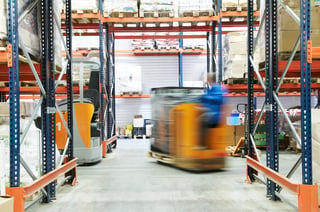Remember Aesop's fable about the tortoise and the hare? The moral was, "slow and steady wins the race." But when it comes to winning the race you run every day as a distributor, "slow" is the very last thing you want to be.
Business velocity matters in distribution because we live in an on-demand world where customers expect same-day shipping and next-day delivery. They want their complete orders in hand ASAP and if you lose one sale to a faster competitor (or if you ship a wrong item), then you've probably lost that customer, too.
You can't just throw people at the problem.
A common response to the velocity challenge is, "We don't move fast enough because we don't have enough people." Well, bringing more hands on deck might help, up to a point. Put more people on the phones and they can take more orders. Put more pickers in your warehouse and they can fill more orders. Add drivers and they can deliver more orders.
But labor is expensive, and the wage and benefits costs (plus additional equipment) don't necessarily bring economies of scale—or velocity—to your operations.
- You can only add so many people to your existing space.
- Also, people make mistakes, so when you add people the opportunities for error multiply.
- When you're making mistakes filling orders, you're making customers unhappy and getting them to think about switching suppliers. (And don't forget about the time lost and costs incurred in fixing the error.)
But even if you're getting every order perfect, you can never achieve maximum business velocity in distribution if you're still using manual processes.
Velocity in Distribution: Before and After
Let me tell you about one distributor we've been working with for more than a decade. They're a textbook example of how a small distribution enterprise can transform from "slow and steady" to greased lightning.
THEN:
When we met, one of the company's co-owners would spend every day on the road, making sales calls. He'd write orders down on paper forms and call them into the office from the field the first chance he could get.
Back at the warehouse, staff would have to hand-write the order (again), verify the customer's credit, check inventory availability, find the items in the warehouse, pack them up, and put them on a truck. There the orders would sit until the best route for the loaded delivery vehicle could be determined.
The whole process was manual, slow, and error-prone.
NOW:
The company today has a full-time field sales staff of five. They're all equipped with mobile technology that allows them to take orders at a customer's place of business—and the system does the rest automatically in real time:
- Checking credit
- Checking inventory
- Sending the order into the company's accounting, warehouse management, and shipping systems
- Sending warehouse pickers directly to the items ordered
- Instructing shipping staff as to which vehicle to load the order into
- Determining the most efficient routes for each delivery vehicle
After the field salesperson inputs the order, the only human involvement is in picking, packing, and shipping (unless there's a special situation, which I'll discuss shortly).
Download the Report now: "Digital Strategies in Distribution"
Velocity is in the system. So what makes a good distribution system?
The only way for distributors to achieve maximum business velocity—to become 21st-century distributors—is through distribution technology systems. This distributor's example demonstrates the two principal and related advantages of a good distribution system: efficiency and accuracy. The opportunity is clear. How do you seize it?
Improved operational efficiency
You just read about the real-time efficiency of order processing in a good distribution system. Let's look closer at how technology can significantly ramp up efficiency and velocity in warehouse operations:
Studies have shown that on average, warehouse workers spend approximately 70% of their time looking for inventory items. And by "looking for," I mean, "Anyone know where we keep gaskets?" and "I know I saw those filters here last week."

The right distribution system tells warehouse staff precisely where to find the inventory they're looking for—the aisle, the shelf, the bin. With less wasted motion, orders are picked, packed, and shipped faster. That's velocity, and velocity matters because:
- Customers want their orders when they want them.
- The faster you can fill orders, the more orders you can fill in a day—and the more customers you can make happy.
Improved order accuracy
Every manual process is an opportunity for human error. And when human errors compromise order accuracy, your enterprise is exposed to risks:
Financial risk: You incur significant costs in money (including shipping and "goodwill" credits or discounts) and time with every return you need to process.
Customer retention risk: Customers who move their business to a competitor who can get every order right represent a significant financial risk to a distributor operating with error-prone manual processes. (And remember: It's generally accepted in business that acquiring new customers costs five times as much as retaining existing, long-term customers.)
The secret: rules and exceptions
At a very basic level, distribution systems operate with rules that move operational functions along at computer speed. Let's go back to an order taken in the field by my client. Rules are programmed into their system that automatically check customer credit, check inventory availability, instruct pickers and packers, and determine delivery routing.
If there's nothing wrong, everything moves at max velocity—no friction, no holdups. BUT if a customer's credit doesn't check out, or an item is out of stock, a programmed exception immediately alerts one of your staffers to secure payment from the customer or (here's that "special situation" I hinted at) initiate a back-order process—which is also automated so the order ships immediately when items arrive. Any lost time is minimized.
To achieve business velocity, start thinking differently about your business.
Earlier I said that you can't sustainably throw people at your velocity challenge. I also believe that you can't throw patchwork technology at the challenge, either.
It takes some visionary thinking, and a willingness to go beyond just shopping for technology tools and instead examining critically all the processes within your distribution enterprise. I guarantee you can find end-to-end opportunities to gain business velocity. An end-to-end solution (instead of disparate tech, cobbled together) will deliver velocity across your enterprise.
By investing in systems, you invest in velocity. And when you have velocity, you're selling better, you're operating more profitably, and you're delivering better customer service. In other words, you're thriving.
What's slowing down your distribution enterprise? We'd like to learn about your goals and challenges, so please reach out anytime. And be sure to download the ebook, "The Age of The Amazons: How to Thrive in the New Competitive Universe."






